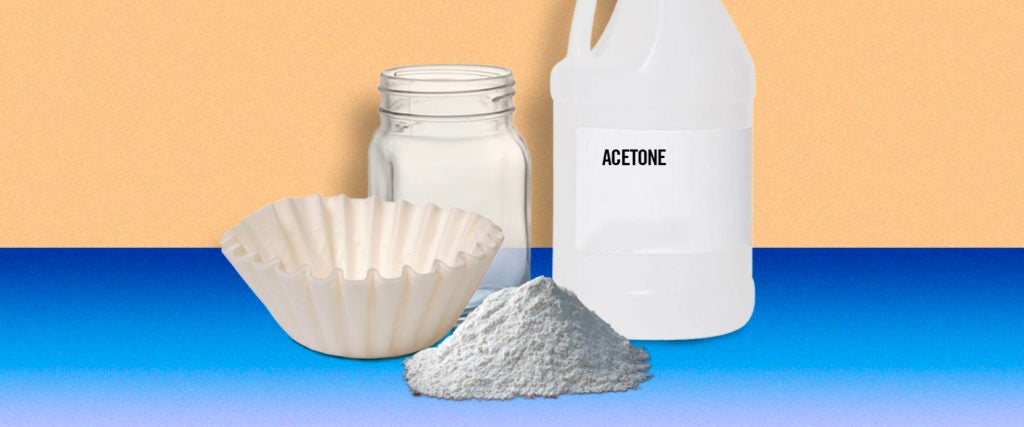Sick of pesky cutting agents in your coke?
Me, too. Fortunately, there’s a simple way to remove at least some of them. It’s called an “acetone wash,” and Matthew Aragón, who helped found the New Mexico chapter of DanceSafe, a public health organization that promotes safety among nightlife and electronic music communities, talked me through the process.
Drop that straw for now — we have coke to clean.
What You’ll Need
Before we get started, you’ll need to go shopping for the following items: A mason jar, coffee filters, anhydrous acetone (or regular acetone and epsom salt), and of course, cocaine. (Keep in mind that acetone is hazardous and highly flammable, so everything I’m about to discuss should be performed in a well-ventilated environment away from open flames and sparks.)
It’s absolutely crucial that your acetone is anhydrous, which means it doesn’t contain any water. That’s because cocaine is soluble in water, so using non-anhydrous acetone will result in a major waste of blow.
While you can buy anhydrous acetone at chemical supply stores, you can also make your own out of regular acetone from a hardware store (not nail polish remover that contains acetone; pure acetone that doesn’t have coloring agents or denatonium benzoate, an extremely sour chemical meant to prevent accidental ingestion).
Here’s how:
- Spread epsom salt onto a baking pan.
- Bake at 200 degrees Fahrenheit for one hour.
- Stir the epsom salt, pulling any moist clumps away from the base of the pan.
- Bake again at 250 degrees Fahrenheit until the epsom salt looks dry.
- Stir.
- Bake at 300 degrees Fahrenheit until the epsom salt looks dry.
- Stir.
- Bake at 350 degrees Fahrenheit until the epsom salt looks dry.
- Stir.
- Bake at 400 degrees Fahrenheit until the epsom salt looks dry.
- Stir.
- Bake at 500 degrees Fahrenheit until the epsom salt looks dry.
The speed of the process depends on your oven, but as the heat gets higher, you should keep a closer eye on your epsom salt to make sure it doesn’t burn. All said and done, the process should take three or four hours. Here’s another look at how it’s done if you’re a visual learner:
Once you’ve dried epsom salt, grab a container (if you’re only cleaning a gram of coke, a shot glass should suffice, but go bigger if you have more blow — you’ll need “about 15 to 20 milliliters of anhydrous acetone per gram of product,” according to Aragón, and there are 44 milliliters in a shot glass). Then, fill one-fifth of your container with epsom salt and the rest with acetone. Lastly, shake and let the mixture sit for 24 hours. This will remove any water from your acetone and make it anhydrous, meaning none of your precious coke will go to waste.
How It’s Done
Now that you have everything you need to clean your coke, here’s the process:
- Crush your cocaine finely, and pour it into your mason jar.
- Add your anhydrous acetone to the mason jar, covering your cocaine completely. If you made your own anhydrous acetone, the epsom salt should be settled at the base of the container, so pour slowly from the top layer so as to not make salted cocaine (that’s no good).
- Stir the solution, then pour the contents through a coffee filter. The coke itself should remain on the filter, while the acetone (and hopefully some nasty cutting agents) drips through. If there’s any leftover coke in the mason jar, just add more acetone and repeat the process.
- Place the coffee filter on a ceramic plate and allow any remaining acetone to evaporate for 24 to 48 hours. Hard as it can be to resist going for a line, this step is important, because as Aragón says, “Acetone doesn’t feel very good to put in your nose.” Once the acetone is gone, it should look just like a wedge of cocaine, which you’ll have to crush up again before you suck it into your nose.
- Do your blow and have a great time.
Because coke isn’t soluble in acetone, Aragón says that any cutting agents that are soluble in acetone — like nicotinamide, a dietary supplement, polyethylene glycol, a laxative, and acetaminophen, a generic form of Tylenol — will come through the coffee filter, leaving you with cleaner cocaine. Importantly, acetone washing doesn’t remove levamisole, a common adulterant found in coke that can cause necrosis of the face (there are other methods for separating levamisole from cocaine, but they’re not practical unless you have a good knowledge of chemistry). It also doesn’t necessarily make your blow a whole lot safer in terms of fentanyl contamination, so testing your cocaine is still highly recommended.
In fact, the point of an acetone wash isn’t necessarily to make your coke “safer.” What it does is remove fillers and bulking agents, which should theoretically result in cocaine that’s easier on the nose and more pure, meaning you’ll get more of the effects you want from less product.
Okay, chemistry class is over.

